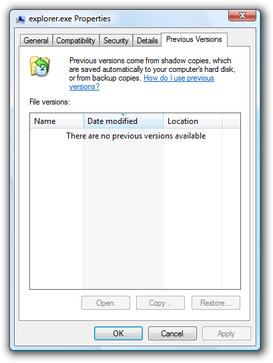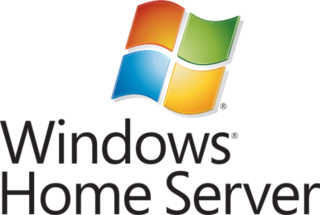This article needs additional citations for verification .(October 2017) |
The archive bit is a file attribute used by CP/M, Microsoft operating systems, OS/2, and AmigaOS. It is used to indicate whether or not the file has been backed up (archived).
This article needs additional citations for verification .(October 2017) |
The archive bit is a file attribute used by CP/M, Microsoft operating systems, OS/2, and AmigaOS. It is used to indicate whether or not the file has been backed up (archived).
In Windows and OS/2, when a file is created or modified, the archive bit is set (i.e. turned on), and when the file has been backed up, the archive bit is cleared (i.e. turned off). Thus, the meaning of the archive bit is "this file has not been archived". In CP/M, the meaning is inverted: creating or modifying a file clears the archive bit, and the bit is set when the file is backed up.
Backup software may provide the option to do a full backup while clearing archive bits – that is, to back up all files regardless of their archive bit status, and to clear the archive bit for all files processed by the backup. This allows for the creation of an initial full backup that will be supplemented by incremental backups in the future. Later, the incremental backup task uses the archive bit to distinguish which files have already been backed up, and selects only the new or modified files for backup.
The operating system never clears the archive bit unless explicitly told to do so by the user. Even when a user explicitly tells the operating system to copy a file for the purpose of archiving it, the archive bit will still not be cleared. A specific command for clearing or setting the bit must be executed. On the other hand, whenever a file with a clear archive bit is modified (edited), or copied or moved to a new location, the operating system will set the archive bit on the target file. Typically on a file system that has never been formally backed up, nearly all of the files will have their archive bits set, as there are few applications that make use of archive bits without the user's request.
In MS-DOS as well as nearly all versions of Windows, status of the archive bit can be viewed or changed with the attrib command-line utility, or by viewing the properties of a file with the Windows shell or Windows Explorer. The archive bit's status can also be viewed or changed with the GetFileAttributes, [1] GetFileAttributesEx, [2] and SetFileAttributes [3] Windows APIs. The archive bit can be set or cleared with the attributes property [4] in VBScript or JScript.
The archive bit is a file attribute and not part of the file itself, so the contents of the file remain unchanged when the status of the archive bit changes.
Relying on the archive bit for backing up files can be unreliable if multiple backup programs are setting and clearing the archive bit on the same volume. [5] Another possibility is to use the timestamp of the last change to the file or directory. This is typically the technique used in UNIX-like operating systems.
New Technology File System (NTFS) is a proprietary journaling file system developed by Microsoft. Starting with Windows NT 3.1, it is the default file system of the Windows NT family. It superseded File Allocation Table (FAT) as the preferred filesystem on Windows and is supported in Linux and BSD as well. NTFS reading and writing support is provided using a free and open-source kernel implementation known as NTFS3 in Linux and the NTFS-3G driver in BSD. By using the convert command, Windows can convert FAT32/16/12 into NTFS without the need to rewrite all files. NTFS uses several files typically hidden from the user to store metadata about other files stored on the drive which can help improve speed and performance when reading data. Unlike FAT and High Performance File System (HPFS), NTFS supports access control lists (ACLs), filesystem encryption, transparent compression, sparse files and file system journaling. NTFS also supports shadow copy to allow backups of a system while it is running, but the functionality of the shadow copies varies between different versions of Windows.

The Windows API, informally WinAPI, is Microsoft's core set of application programming interfaces (APIs) available in the Microsoft Windows operating systems. The name Windows API collectively refers to several different platform implementations that are often referred to by their own names. Almost all Windows programs interact with the Windows API. On the Windows NT line of operating systems, a small number use the Native API.
Microsoft BASIC is the foundation software product of the Microsoft company and evolved into a line of BASIC interpreters and compiler(s) adapted for many different microcomputers. It first appeared in 1975 as Altair BASIC, which was the first version of BASIC published by Microsoft as well as the first high-level programming language available for the Altair 8800 microcomputer.
In computing, a symbolic link is a file whose purpose is to point to a file or directory by specifying a path thereto.
In computing, a hard link is a directory entry that associates a name with a file. Thus, each file must have at least one hard link. Creating additional hard links for a file makes the contents of that file accessible via additional paths. This causes an alias effect: a process can open the file by any one of its paths and change its content. By contrast, a soft link or “shortcut” to a file is not a direct link to the data itself, but rather a reference to a hard link or another soft link.
The Encrypting File System (EFS) on Microsoft Windows is a feature introduced in version 3.0 of NTFS that provides filesystem-level encryption. The technology enables files to be transparently encrypted to protect confidential data from attackers with physical access to the computer.

In computing, a virtual address space (VAS) or address space is the set of ranges of virtual addresses that an operating system makes available to a process. The range of virtual addresses usually starts at a low address and can extend to the highest address allowed by the computer's instruction set architecture and supported by the operating system's pointer size implementation, which can be 4 bytes for 32-bit or 8 bytes for 64-bit OS versions. This provides several benefits, one of which is security through process isolation assuming each process is given a separate address space.
The Windows Registry is a hierarchical database that stores low-level settings for the Microsoft Windows operating system and for applications that opt to use the registry. The kernel, device drivers, services, Security Accounts Manager, and user interfaces can all use the registry. The registry also allows access to counters for profiling system performance.
In a computer file system, a fork is a set of data associated with a file-system object. File systems without forks only allow a single set of data for the contents, while file systems with forks allow multiple such contents. Every non-empty file must have at least one fork, often of default type, and depending on the file system, a file may have one or more other associated forks, which in turn may contain primary data integral to the file, or just metadata.

Shadow Copy is a technology included in Microsoft Windows that can create backup copies or snapshots of computer files or volumes, even when they are in use. It is implemented as a Windows service called the Volume Shadow Copy service. A software VSS provider service is also included as part of Windows to be used by Windows applications. Shadow Copy technology requires either the Windows NTFS or ReFS filesystems in order to create and store shadow copies. Shadow Copies can be created on local and external volumes by any Windows component that uses this technology, such as when creating a scheduled Windows Backup or automatic System Restore point.
File attributes are a type of meta-data that describe and may modify how files and/or directories in a filesystem behave. Typical file attributes may, for example, indicate or specify whether a file is visible, modifiable, compressed, or encrypted. The availability of most file attributes depends on support by the underlying filesystem where attribute data must be stored along with other control structures. Each attribute can have one of two states: set and cleared. Attributes are considered distinct from other metadata, such as dates and times, filename extensions or file system permissions. In addition to files, folders, volumes and other file system objects may have attributes.
Dynamic-link library (DLL) is Microsoft's implementation of the shared library concept in the Microsoft Windows and OS/2 operating systems. These libraries usually have the file extension DLL, OCX, or DRV . The file formats for DLLs are the same as for Windows EXE files – that is, Portable Executable (PE) for 32-bit and 64-bit Windows, and New Executable (NE) for 16-bit Windows. As with EXEs, DLLs can contain code, data, and resources, in any combination.
Compared with previous versions of Microsoft Windows, features new to Windows Vista are very numerous, covering most aspects of the operating system, including additional management features, new aspects of security and safety, new I/O technologies, new networking features, and new technical features. Windows Vista also removed some others.
To quiesce is to pause or alter a device or application to achieve a consistent state, usually in preparation for a backup or other maintenance.
Windows Vista introduced a number of new I/O functions to the Microsoft Windows line of operating systems. They are intended to shorten the time taken to boot the system, improve the responsiveness of the system, and improve the reliability of data storage.

In computing, ATTRIB is a command in Intel ISIS-II, DOS, IBM OS/2, Microsoft Windows and ReactOS that allows the user to change various characteristics, or "attributes" of a computer file or directory. The command is also available in the EFI shell.

Windows Home Server is a home server operating system from Microsoft. It was announced on 7 January 2007 at the Consumer Electronics Show by Bill Gates, released to manufacturing on 16 July 2007 and officially released on 4 November 2007.
NTBackup is the built-in backup application introduced in Windows NT 3.51 and included in Windows NT 4.0, Windows 2000, Windows XP, and Windows Server 2003. NTBackup comprises a command-line utility and a set of wizard interfaces that provide multiple options to create, customize, and manage backups, and it is integrated with Shadow Copy and Task Scheduler. NTBackup creates backups in a proprietary BKF file format to external sources including floppy disks, hard drives, tape drives, and ZIP drives.
A roaming user profile is a file synchronization concept in the Windows NT family of operating systems that allows users with a computer joined to a Windows domain to log on to any computer on the same domain and access their documents and have a consistent desktop experience, such as applications remembering toolbar positions and preferences, or the desktop appearance staying the same, while keeping all related files stored locally, to not continuously depend on a fast and reliable network connection to a file server.
Windows NT is a proprietary graphical operating system produced by Microsoft, the first version of which was released on July 27, 1993. It is a processor-independent, multiprocessing and multi-user operating system.